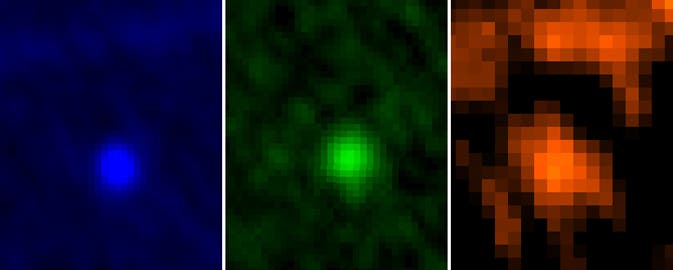Due to a “closer” approach of asteroid Apophis this month of just 40 Earth-Moon distances, astronomers were able to get a better glimpse of the much talked about asteroid in order to better understand it. Thomas Müller of the Max Planck Institute for Extraterrestrial Physics in Garching, Germany, who is leading the analysis of the new data, said that one of the things they were able to observe was a “20% increase in diameter, from 270 to 325 m,[that] translates into a 75% increase in our estimates of the asteroid’s volume or mass.”

Pictures taken on Jan. 5 and 6, 2013 by the ESA’s Herschel Space Observatory using its Photodetecting Array Camera and Spectrometer instrument. The image shows asteroid Apophis in three wavelengths: 70, 100 and 160 microns, respectively. Image credit: ESA/Herschel/PACS/MACH-11/MPE/ESAC
After it’s discovery in 2004, Apophis, the now famous asteroid, came to the attention of scientists as it was flagged by several automated software that checked newly discovered near-earth objects for the possibility of close encounters with Earth and the probability of an impact event. The object initially named 2004 MN4 had the highest impact probability so far discovered of all the objects approaching Earth, a probability of 2,7 %, in a close encounter that will happen in April 13th 2029 in which it was presumed to be likely to hit either the Earth or the Moon. After discovering this fact, the asteroid received a permanent number 99942 and it was later named after an enemy of the ancient sun-god Ra.
In later years, astronomers were able to better calculate the orbit of the asteroid after making more detailed observations and in doing so, they excluded the probability of an impact event with either the Earth or the Moon in the 2029 close encounter, but they did realise that the close encounter will reconfigure its orbit and it would create another potentially dangerous approach in April 2036.
This January the asteroid gets close enough to Earth the astronomers say – about 40 times the Earth – Moon distance (or 0.0966 AU) – in order to allow a better estimate of it’s future orbit. As of January 9th, the calculations revealed that even in the approach in April 2036 Apophis has a probability of impact of 1 in 7,143,000. The asteroid’s trajectory will be calculated again after the observations that will be done by the Goldstone Observatory in the US, and then by the Arecibo Observatory, after the asteroid enters the Arecibo’s declination window after February 13th.
[Via NASA News]









